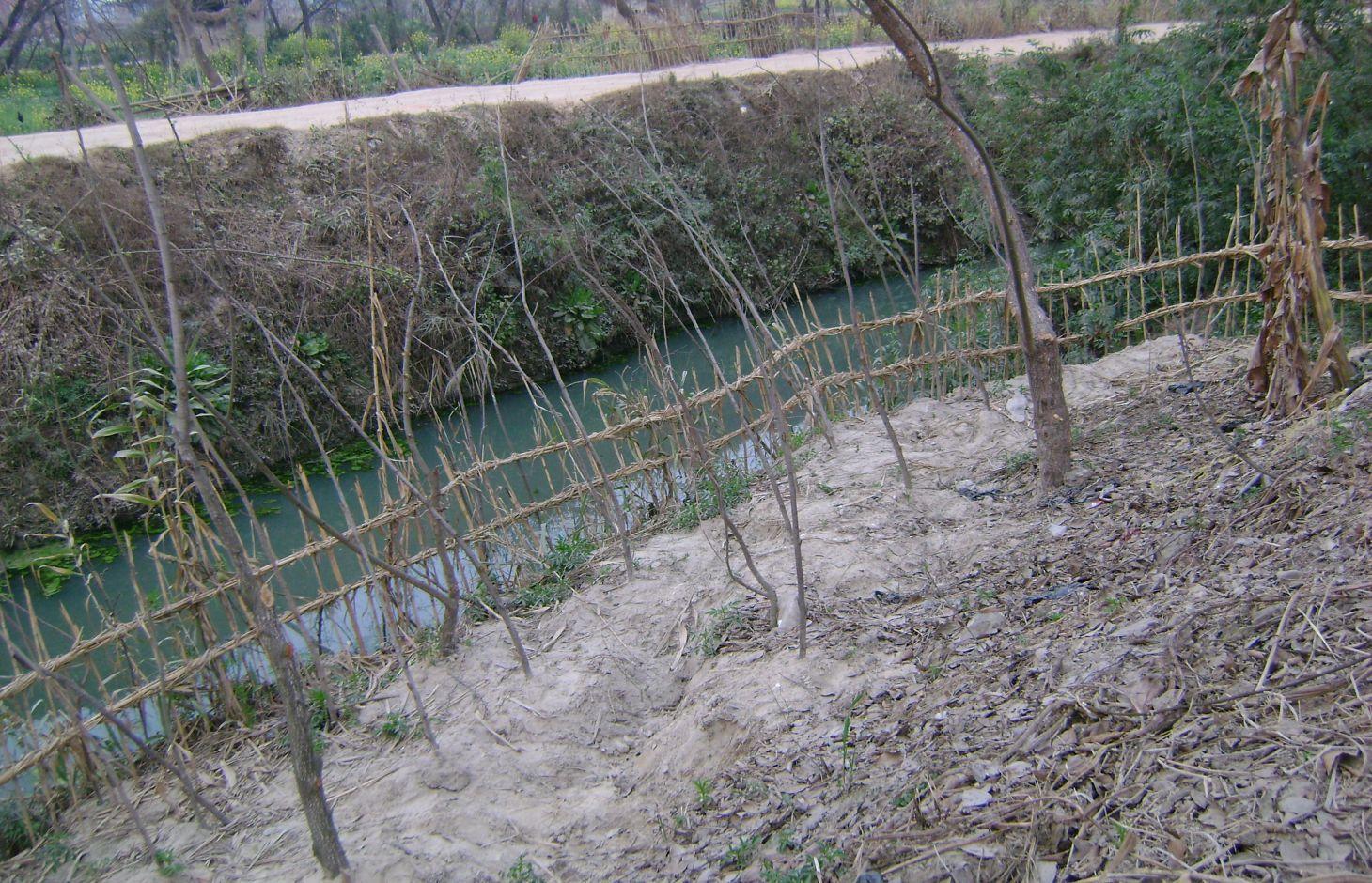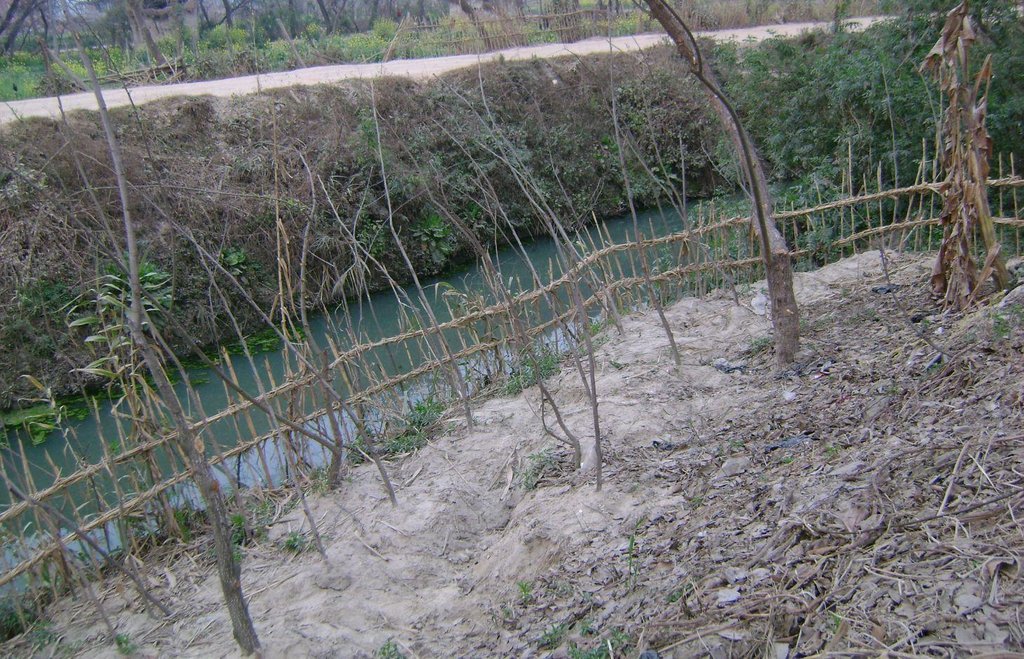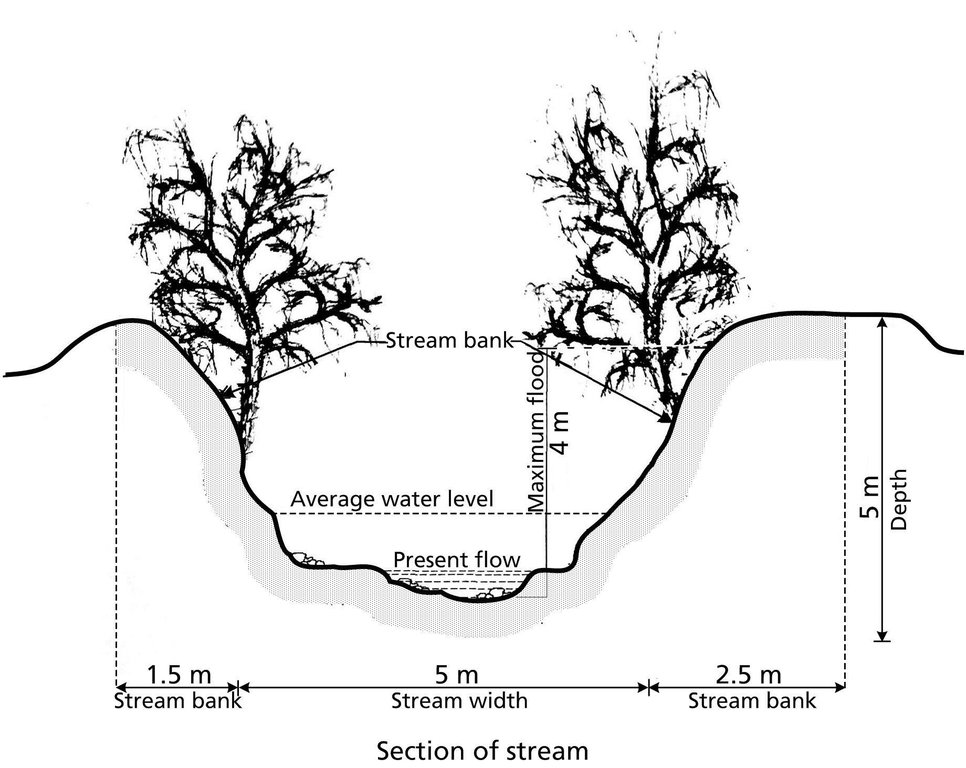Using Salix plant to protect stream banks [Nepal]
- Creation:
- Update:
- Compiler: Shreedip Sigdel
- Editor: –
- Reviewers: David Streiff, Alexandra Gavilano
Baais ropi khola kinar samrakshan
technologies_1693 - Nepal
View sections
Expand all Collapse all1. General information
1.2 Contact details of resource persons and institutions involved in the assessment and documentation of the Technology
SLM specialist:
Mulepati Indira
Department of Soil Conservation and Watershed Management
Nepal
Name of the institution(s) which facilitated the documentation/ evaluation of the Technology (if relevant)
Department of Soil Conservation and Watershed Mana (Department of Soil Conservation and Watershed Mana) - NepalName of the institution(s) which facilitated the documentation/ evaluation of the Technology (if relevant)
ICIMOD International Centre for Integrated Mountain Development (ICIMOD) - Nepal1.3 Conditions regarding the use of data documented through WOCAT
The compiler and key resource person(s) accept the conditions regarding the use of data documented through WOCAT:
Yes
2. Description of the SLM Technology
2.1 Short description of the Technology
Definition of the Technology:
Stream banks can be protected by planting them with Salix (Salix babylonica); this is a traditional practice that has been used for streams that flow through agricultural lands.
2.2 Detailed description of the Technology
Description:
The erosion of stream banks is a natural geomorphic process, but when the streams flow through agricultural land there is a danger that they can overrun their banks and damage crops or erode land used for cultivation. The degree of erosion can be reduced by using structural measures such as lining the banks with concrete or large boulders or by planting trees along the edges. The Salix plant (Salix babylonica) has been found to be particularly useful for preventing erosion because its roots extend deep into the soil and help to anchor the bank. Following age-old tradition, land users in Bhaktapur district have planted Salix along the Bramayaeni khola (stream). It is a low-cost technology that is simple to implement.
Purpose of the Technology: Salix does best in moist soils, such as those found along irrigation channels and along the banks of rivers and streams. Salix saplings are most commonly planted in single rows but sometimes in double rows. After the saplings are planted, the entire area is fenced off using a biofence to protect them from being eaten or trampled by wild animals. Land users keep an eye on the Salix and prune or thin them as needed, for example when it is shading crops, or when they need firewood or can sell the branches.
2.3 Photos of the Technology
2.5 Country/ region/ locations where the Technology has been applied and which are covered by this assessment
Country:
Nepal
Further specification of location:
Bhaktapur Municipality-2, Nantukucha, Bhaktapur District
Specify the spread of the Technology:
- applied at specific points/ concentrated on a small area
Comments:
Total area covered by the SLM Technology is 0.026 km2.
3. Classification of the SLM Technology
3.1 Main purpose(s) of the Technology
- reduce, prevent, restore land degradation
3.2 Current land use type(s) where the Technology is applied

Cropland
- Annual cropping
Number of growing seasons per year:
- 2
Comments:
Major land use problems (compiler’s opinion): When streams overflow their banks, agricultural land can be flooded and eroded.
3.5 SLM group to which the Technology belongs
- improved plant varieties/ animal breeds
- surface water management (spring, river, lakes, sea)
3.6 SLM measures comprising the Technology

vegetative measures
- V1: Tree and shrub cover
3.7 Main types of land degradation addressed by the Technology

soil erosion by water
- Wr: riverbank erosion
Comments:
Main causes of degradation: floods
3.8 Prevention, reduction, or restoration of land degradation
Specify the goal of the Technology with regard to land degradation:
- prevent land degradation
4. Technical specifications, implementation activities, inputs, and costs
4.1 Technical drawing of the Technology
Technical specifications (related to technical drawing):
Schematic diagram of a low cost riverbank protection scheme that can be implemented using mostly local materials.
Technical knowledge required for land users: moderate
Main technical functions: The Salix roots reinforce the soil and support it by buttressing and arching., Salix armours the slope against surface erosion
Secondary technical functions: Floodwater is safely channeled downstream
Author:
Bhojdeo Mandal, AK Thaku
4.2 General information regarding the calculation of inputs and costs
Specify how costs and inputs were calculated:
- per Technology area
Indicate size and area unit:
ha
Specify currency used for cost calculations:
- USD
4.3 Establishment activities
| Activity | Timing (season) | |
|---|---|---|
| 1. | The planting site is cleared. Cuttings are taken from 3–5 year-old trees: average length: 2–2.5 m; average diameter: 5–7 mm. | January-febuary |
| 2. | Planting pits approximately 30 cm in diameter and 90 cm deep are dug into the stream bank approximately 1–2 m apart. | |
| 3. | The Salix cuttings are planted so that one-third of their length is below the surface of the soil. | |
| 4. | After planting, the soil is compacted around the base of the cuttings. | |
| 5. | The cuttings are watered soon after planning and again at least three times per month. In June and July, six months after planting, the cuttings that have survived and taken hold should show new shoots. |
4.4 Costs and inputs needed for establishment
| Specify input | Unit | Quantity | Costs per Unit | Total costs per input | % of costs borne by land users | |
|---|---|---|---|---|---|---|
| Labour | Clear planting side | persons/day/ha | 150.0 | 3.9 | 585.0 | 100.0 |
| Construction material | Salix cutting | ha | 1.0 | 186.0 | 186.0 | 100.0 |
| Total costs for establishment of the Technology | 771.0 | |||||
| Total costs for establishment of the Technology in USD | 771.0 | |||||
Comments:
Duration of establishment phase: 2 month(s)
4.5 Maintenance/ recurrent activities
| Activity | Timing/ frequency | |
|---|---|---|
| 1. | The established Salix is thinned or pruned if it is found to be shading crops. New cuttings are planted in areas where cuttings have failed to take root. |
4.6 Costs and inputs needed for maintenance/ recurrent activities (per year)
| Specify input | Unit | Quantity | Costs per Unit | Total costs per input | % of costs borne by land users | |
|---|---|---|---|---|---|---|
| Labour | Thinning and prunning | persons/day/ha | 10.0 | 3.9 | 39.0 | 100.0 |
| Construction material | New salix cutting | ha | 1.0 | 35.0 | 35.0 | 100.0 |
| Total costs for maintenance of the Technology | 74.0 | |||||
| Total costs for maintenance of the Technology in USD | 74.0 | |||||
4.7 Most important factors affecting the costs
Describe the most determinate factors affecting the costs:
The labour cost is very high in Bhaktapur District; when compared to other parts of the country it is probably the highest. All costs and amounts are rough estimates by the technicians and authors
5. Natural and human environment
5.1 Climate
Annual rainfall
- < 250 mm
- 251-500 mm
- 501-750 mm
- 751-1,000 mm
- 1,001-1,500 mm
- 1,501-2,000 mm
- 2,001-3,000 mm
- 3,001-4,000 mm
- > 4,000 mm
Agro-climatic zone
- sub-humid
Thermal climate class: temperate
5.2 Topography
Slopes on average:
- flat (0-2%)
- gentle (3-5%)
- moderate (6-10%)
- rolling (11-15%)
- hilly (16-30%)
- steep (31-60%)
- very steep (>60%)
Landforms:
- plateau/plains
- ridges
- mountain slopes
- hill slopes
- footslopes
- valley floors
Altitudinal zone:
- 0-100 m a.s.l.
- 101-500 m a.s.l.
- 501-1,000 m a.s.l.
- 1,001-1,500 m a.s.l.
- 1,501-2,000 m a.s.l.
- 2,001-2,500 m a.s.l.
- 2,501-3,000 m a.s.l.
- 3,001-4,000 m a.s.l.
- > 4,000 m a.s.l.
5.3 Soils
Soil depth on average:
- very shallow (0-20 cm)
- shallow (21-50 cm)
- moderately deep (51-80 cm)
- deep (81-120 cm)
- very deep (> 120 cm)
Soil texture (topsoil):
- medium (loamy, silty)
Topsoil organic matter:
- high (>3%)
If available, attach full soil description or specify the available information, e.g. soil type, soil PH/ acidity, Cation Exchange Capacity, nitrogen, salinity etc.
Soil fertility is high
Soil drainage / infiltration is good
Soil water storage capacity is medium
5.4 Water availability and quality
Ground water table:
> 50 m
Availability of surface water:
good
Water quality (untreated):
for agricultural use only (irrigation)
5.5 Biodiversity
Species diversity:
- medium
5.6 Characteristics of land users applying the Technology
Market orientation of production system:
- mixed (subsistence/ commercial)
Off-farm income:
- > 50% of all income
Relative level of wealth:
- rich
Individuals or groups:
- individual/ household
Level of mechanization:
- manual work
Indicate other relevant characteristics of the land users:
Population density: > 500 persons/km2
Annual population growth: 2% - 3%
5.7 Average area of land used by land users applying the Technology
- < 0.5 ha
- 0.5-1 ha
- 1-2 ha
- 2-5 ha
- 5-15 ha
- 15-50 ha
- 50-100 ha
- 100-500 ha
- 500-1,000 ha
- 1,000-10,000 ha
- > 10,000 ha
5.8 Land ownership, land use rights, and water use rights
Land ownership:
- individual, titled
Land use rights:
- individual
Water use rights:
- communal (organized)
5.9 Access to services and infrastructure
health:
- poor
- moderate
- good
education:
- poor
- moderate
- good
technical assistance:
- poor
- moderate
- good
employment (e.g. off-farm):
- poor
- moderate
- good
markets:
- poor
- moderate
- good
energy:
- poor
- moderate
- good
roads and transport:
- poor
- moderate
- good
drinking water and sanitation:
- poor
- moderate
- good
financial services:
- poor
- moderate
- good
6. Impacts and concluding statements
6.1 On-site impacts the Technology has shown
Socio-economic impacts
Production
fodder production
risk of production failure
production area
Comments/ specify:
New land can be brought under cultivation
Income and costs
diversity of income sources
Socio-cultural impacts
community institutions
SLM/ land degradation knowledge
livelihood and human well-being
Comments/ specify:
Farm income is increased when more land is available for cultivation and when more fodder and fuelwood are available
Ecological impacts
Water cycle/ runoff
excess water drainage
evaporation
Soil
soil loss
Biodiversity: vegetation, animals
biomass/ above ground C
Climate and disaster risk reduction
flood impacts
Comments/ specify:
reduced susceptibility to adverse events such as floods
Other ecological impacts
Salik can shade crop
6.2 Off-site impacts the Technology has shown
water availability
Comments/ specify:
Improved water availability downstream because water remains contained in the stream
damage on public/ private infrastructure
Comments/ specify:
Reduced probability of flooding
6.3 Exposure and sensitivity of the Technology to gradual climate change and climate-related extremes/ disasters (as perceived by land users)
Gradual climate change
Gradual climate change
| Season | increase or decrease | How does the Technology cope with it? | |
|---|---|---|---|
| annual temperature | increase | well |
Climate-related extremes (disasters)
Climatological disasters
| How does the Technology cope with it? | |
|---|---|
| drought | not well |
Hydrological disasters
| How does the Technology cope with it? | |
|---|---|
| general (river) flood | well |
6.4 Cost-benefit analysis
How do the benefits compare with the establishment costs (from land users’ perspective)?
Short-term returns:
positive
Long-term returns:
very positive
How do the benefits compare with the maintenance/ recurrent costs (from land users' perspective)?
Short-term returns:
very positive
Long-term returns:
very positive
6.5 Adoption of the Technology
If available, quantify (no. of households and/ or area covered):
148 households
Of all those who have adopted the Technology, how many did so spontaneously, i.e. without receiving any material incentives/ payments?
- 91-100%
Comments:
There is a strong trend towards spontaneous adoption of the Technology
Comments on adoption trend: All of the 148 households studied implement this technology voluntarily without external support.
6.7 Strengths/ advantages/ opportunities of the Technology
| Strengths/ advantages/ opportunities in the compiler’s or other key resource person’s view |
|---|
|
It is a successful example of sustainable land management that has been very effective in Nepal. How can they be sustained / enhanced? An awareness programme on the importance of stream bank protection would help to validate and reconfirm this age-old practice. |
|
This low-cost technology is applied using indigenous knowledge. How can they be sustained / enhanced? Scientific and technical input might help to make this technology more effective. |
6.8 Weaknesses/ disadvantages/ risks of the Technology and ways of overcoming them
| Weaknesses/ disadvantages/ risks in the compiler’s or other key resource person’s view | How can they be overcome? |
|---|---|
| There are no funds to help extend the technology to other areas. | More funding should be made available for stream bank protection either from the District Soil Conservation Office or private organizations. |
| When newly planted Salix cuttings are overrun by khosima, a new invasive species, they gradually die. | Technical backstopping is needed for the removal of unwanted species. |
7. References and links
7.1 Methods/ sources of information
Links and modules
Expand all Collapse allLinks
No links
Modules
No modules





